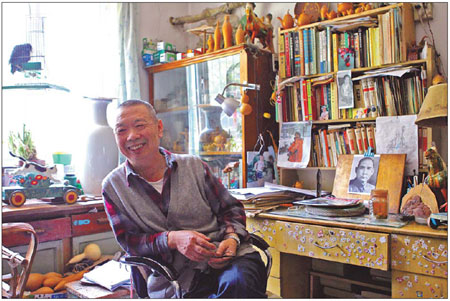Art
Artist of a million cuts
Updated: 2011-05-04 08:01
By Wu Wencong (China Daily)
|
Mao Zifang says the craft of carving on porcelain belongs to China and will pass it on to whoever has the talent. Photos by Zou Hong / China Daily |

Legend says an emperor first thought of carving porcelain, but a modern craftsman has perfected the skill, Wu Wencong reports.
In most people's eyes, the dark-glazed ceramic plate is nothing more than a cheap tool to be put under a flower pot to stop water leaking; but under Mao Zifang's hands it is turned into something valuable, and has even become a gift China gives to foreign leaders.
The craft practiced by the 68-year-old Mao is called carving on porcelain, which in other words can be described as tattooing on ceramic plates.
It is said that an emperor in the Song Dynasty (960-1279) liked to have his collection of paintings redrawn on porcelain, but was afraid that the color might fade over time. To make the colors stay, he asked craftsmen to carve the lines of the paintings into the porcelain, turning drawing into tattooing.
The traditional process starts with drawing the draft patterns on white porcelain plates using a brush, and then carefully chiseling lines on the glaze on the plate by holding an iron rod with a tungsten-steel tip in the left hand and a hammer in the right. The last step is coloring the lines with paint.
Mao worked the same way for more than 20 years, from the 1960s to the 1980s. Meanwhile, he had been trying out the effects on different types of porcelain to discover new techniques. In the 1980s he succeeded by replacing white plates with dark-glazed ones.
The porcelain plate has a darker glaze but a much lighter body.
The color of the glaze and the body appear in extreme contrast, which is ideal for showing shadows even without the last step of coloring.
"Dark-glazed porcelain plates are also thicker than white ones, which enables me to do at least five color layers according to the depth of carving," Mao told METRO.
Mao started to work in a jade factory at the age of 19. In the same year, he saw an exhibition featuring carved porcelain works by a famous craftsman in Beijing and could not take his eyes off the beautiful plates.
"I kept wondering how such beautiful patterns could be carved into something that is so hard, so I tried myself at home and broke a lot of plates," he laughed.
He said the various shades of the patterns are carved layer after layer. The brighter the place, the more glaze is chiseled.
"It's easy for beginners to forget which layer they are at when carving. Also the plate may break into pieces if you chisel just a little harder, as it becomes thinner after several layers have been carved," he said.
Mao never stopped learning and researching porcelain carving while working at the jade factory. From 1984, he began to be assigned jobs to carve portraits for heads of foreign states, starting with former prime minister Yasuhiro Nakasone of Japan.
The only models Mao has used over the years are photos, one for each portrait.
"Of all the portraits I've carved, most were based on photos that have either been stored for a long time or been recopied many times, and the structures of the faces are no longer clear," said Mao.
When METRO joined him in his home studio, he had been working on a portrait of Sun Yat-sen, the first president of the Republic of China. The photo he was given had been recopied so many times that half of Sun's face was completely white.
"This is when it requires skills other than painting and carving," Mao said. "You need to know something about anatomy to create another photo that can be used as a model."
Mao said each piece of work calls for millions of carving cuts, but when he was young he could finish a portrait in 10 days by working extra shifts. Now it takes him at least a month.
Despite more than 20 years of carving gifts for international leaders and being acclaimed a maestro, Mao's fame and experience have not brought him wealth.
Even though the jade factory built a studio for him in 1999, he seldom uses it as it takes 90 minutes to get there. Most of his works were finished in a 70-square-meter room that houses six people.
Mao's attitude to money and fame reflects his status as a master.
He never entered any competitions, yet he keeps carving gifts from China to international figures. He has a large newspaper collection of all the articles about him since 1986. At the back of this book there were several lines of handwriting that read: "No matter what the reporters say to praise me, it only shows their respect for me. But I need to keep a clear mind about myself and maintain a rational judgment about my work."
Mao has four students at present; the eldest is 52 years old. None of them is a family member.
"The craft belongs to our country, not my family, and I'll pass it on to whoever has the talent," he said. "After all, I didn't learn it from my father in the first place."
Specials

Bin Laden dead
The world's most wanted man was killed in a US raid in Pakistan.

British Royal Wedding
Prince William and Kate Middleton married at Westminster Abbey in a royal occasion of dazzling pomp and pageantry.
Best wishes

The final frontier
Xinjiang is a mysterious land of extremes that never falls to fascinate.
